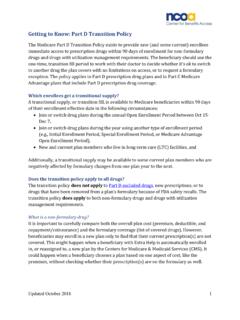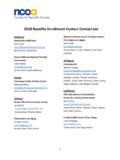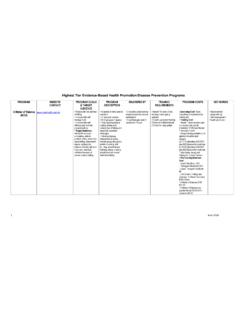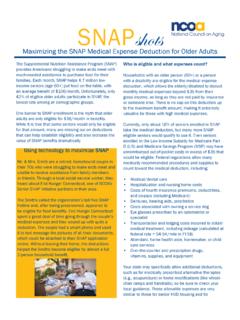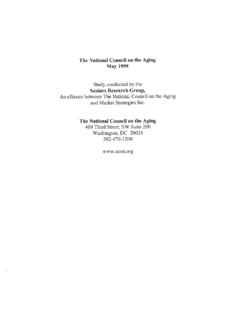Transcription of Otago Exercise Program Overview and Original Research
1 Otago Exercise Program Guidance Statement National Council on Aging 251 18th Street South, Suite 500 arlington , VA 22202 571-527-3900 @NCOA ging The purpose of this document is to provide information and guidance regarding implementation of the Otago Exercise Program for U. S. Administration for Community Living falls prevention grantees and other community-based organizations implementing Otago . Otago Exercise Program Overview and Original Research The Otago Exercise Program (OEP) was developed and tested by Dr.
2 John Campbell and Dr. Clare Robertson at the University of Otago , Otago , New Zealand. Implementation and dissemination of the Program in New Zealand was studied in the mid-late 1990s, and proven to decrease falls and fall-related injuries in high-risk older adults by 46% (Robertson, Devil, Gardner, & Campbell, 2001). The OEP is considered to be one of the most appropriate fall prevention programs for older adults who are frail and may not be able to participate in a group-based Program like Tai Chi. For this reason, the Program was originally designed for delivery in the home by a physical therapist (PT).
3 Designed to continually challenge the participant s strength and balance, the Program consists of: A series of warm up exercises 17 strength and balance exercises conducted in the home for 30 minutes/day, three times/week (three exercises use ankle weights to provide added resistance), Exercises selected and progressed by a PT based on the participant s abilities (the participant does NOT do all 17) A walking Program done for up to 30 minutes/day, three times/week, Five PT participant visits over a period of 8 weeks, Follow up visits at 6 months and one year, and Monthly phone calls during months were there is no face to face interaction.
4 Guidance for the United States Version of the Otago Exercise Program In 2010, the OEP was selected as one of four programs for dissemination by the Centers for Disease Control and Prevention in the United States. As part of the US dissemination project, several aspects of the OEP were modified to facilitate adoption and implementation of the Program by both healthcare providers and community-based organizations. These modifications do not in any way compromise the fidelity of the Program . The United States version of the OEP maintained the following elements: A series of warm-up exercises.
5 Participation in a minimum of 5 sessions over 8 weeks with a provider of the OEP. Select exercises from the 17 OEP exercises which challenge the participant s strength and balance for up to 30 minutes, three times a week. A walking Program for up to 30 minutes, three times a weekOtago Exercise Program Guidance Statement 2 The key modifications of the US Program include: The Program can take place in the home, outpatient clinic, or community setting. The participant can do the exercises on their own, in an Exercise class environment, or using online applications, videos, or virtual programs .
6 Participants can use a variety of tools to track participation rates and progress The Program can be delivered by a PT or a Physical Therapy Assistant (PTA) and be reimbursed by Medicare as long as the participant meets the requirements for physical therapy under Medicare Part A, B, or C. The Program can also be delivered by a community-based organization (by an individual with an Exercise background and experience working with older adults). It is highly recommended that a relationship be established with a PT who can serve as a consultant to insure the participants are appropriate for the Program and can be safely progressed.
7 In the role as a consultant, PTs must be paid by mechanisms other than Medicare as currently there is no code a PT could use to bill for their time in this role. Participation of at least 8 weeks with a PT, with six months the minimum recommended duration for the exercises to be done at home. Outcomes from US Dissemination (Shubert, M. L. Smith, L. Goto, L. Jiang and M. G. Ory , 2017; Shubert, T. E., M. L. Smith, L. Jiang and M. G. Ory, 2016) Improvements in functional outcome measures Improvements in perception of ability to sit, stand, kneel, walk Improvements in balance confidence and fear of falling Target Audience The Original OEP demonstrated the greatest effectiveness with adults age 80 and older.
8 For the US dissemination, the Program was shown to be effective in adults age 65 and older who had a history of falls or were identified at an increased risk for a fall by the STEADI tool. The Program is not appropriate for older adults who screen at low risk for falls or who have the strength and endurance to participate in a community-based Tai Chi class. Participation Requirements Attend a minimum of 5 sessions over 8 weeks with a provider of the OEP. The first session is to introduce the participant to their Exercise plan.
9 The remaining sessions are to insure the participant can perform their Exercise Program either on their own or part of a class and to progress the intensity and challenge of the participant s Program . Sessions can be one-on-one or in a group setting. The sessions must be conducted by a PT, a PTA, or by a community provider with expertise in older adult Exercise instruction. If sessions are conducted by a community provider, it is strongly recommended to establish a relationship with a PT to provide consultation services as needed.
10 Complete their OEP plan up to 30 minutes/day, three days /week. Complete their walking Program up to 30 minutes /day, three days/week. Otago Exercise Program Guidance Statement 3 It is suggested that six months be the minimum commitment by the participant to receive the best benefit from the Program . It is recommended that participants understand that the key to success is to do their OEP Program . If the participant does not do the exercises, they will receive little to no benefit from participation. Instructors can support participation by: Downloading Exercise videos at Working with community-based organizations to offer OEP classes Recommending apps and virtual OEP programs OEP Training The OEP can be delivered by a PT, PT Assistant, or an Exercise instructor.
